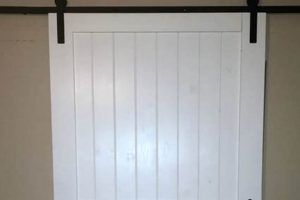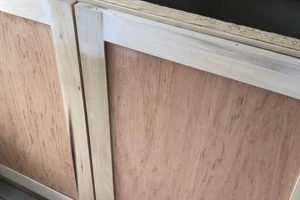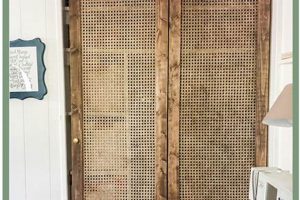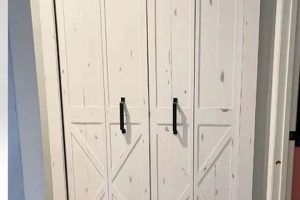A self-assembled barrier designed to fit within the opening of a vehicular access point, typically constructed from mesh and framing materials, provides ventilation and insect protection. These home-built solutions offer an alternative to permanent or professionally installed options. An example includes using fiberglass screening attached to a wooden frame, mounted within the garage door opening.
The value in creating such a structure lies in increased airflow and reduced pest entry, particularly advantageous in climates where natural ventilation is desired. Historically, these adaptations emerged as a practical response to the need for cost-effective climate control and insect deterrence in residential settings. The practice reflects a desire for increased comfort and usability of garage spaces without significant financial investment.
The subsequent sections will detail various construction methods, materials, and considerations for a successful project. These discussions will cover frame construction, screen attachment techniques, and methods for securing the completed assembly within the designated opening, ensuring a functional and aesthetically pleasing outcome.
Construction and Installation Guidance
The following recommendations aim to provide guidance for constructing and installing a suitable barrier for a vehicular access point. These suggestions emphasize practicality, durability, and effectiveness.
Tip 1: Precise Measurement is Crucial. Accurate dimensions of the opening are paramount. Measure the width and height at multiple points to account for any irregularities. This ensures a snug fit and optimal functionality.
Tip 2: Prioritize Durable Materials. Opt for framing materials resistant to weathering and insect damage. Pressure-treated lumber or aluminum are viable choices, increasing longevity and reducing maintenance.
Tip 3: Select Appropriate Screening. Fiberglass or aluminum screening offers a balance of durability and visibility. Consider a tighter weave for enhanced insect protection. Secure the screen tautly to the frame to prevent sagging.
Tip 4: Employ Robust Fasteners. Utilize screws or bolts for frame assembly, rather than nails, to ensure structural integrity. Stainless steel fasteners resist corrosion, extending the lifespan of the frame.
Tip 5: Implement a Secure Mounting System. Employ hinges for ease of access and removal. Ensure the hinges are appropriately sized for the weight of the frame. Consider magnetic or latch closures for secure closure.
Tip 6: Reinforce High-Stress Areas. Add corner braces or additional supports to the frame to mitigate stress and prevent warping or sagging. This is particularly important for larger openings.
Tip 7: Apply Weather Stripping. Install weather stripping around the perimeter of the frame to create a tighter seal, further reducing insect intrusion and improving insulation.
Adherence to these guidelines will result in a more robust and effective structure, providing enhanced comfort and functionality within the designated space.
The subsequent conclusion will summarize the key considerations for this type of project.
1. Precise measurements
The accuracy of dimensional assessments is paramount for the successful implementation of a self-assembled mesh barrier designed for a vehicular access point. Deviations from accurate measurements can result in functional deficiencies and compromised performance.
- Frame Fitment and Stability
Inaccurate measurements directly impact the fit of the frame within the garage door opening. An undersized frame results in gaps, negating the insect-deterrent properties. An oversized frame necessitates forceful installation, potentially damaging the frame or the garage door itself. Stability is compromised if the frame’s dimensions do not align with the opening, leading to warping or eventual failure. For example, if the opening is 96 inches wide, a frame built to 95 inches leaves a gap that defeats the purpose.
- Screen Tension and Longevity
The internal dimensions of the frame, dictated by accurate measurements, influence the tension of the screen material. An improperly sized frame results in either insufficient tension, causing sagging and reducing the barrier’s effectiveness, or excessive tension, potentially tearing the screen or warping the frame. For instance, a frame that is slightly too small internally will overstretch the screen during installation, leading to premature failure, especially in warmer temperatures where the material expands.
- Hardware Alignment and Functionality
Hinge placement, latch alignment, and the functionality of any integrated opening mechanisms are critically dependent on precise dimensional accuracy. If the frame is not square or the dimensions are incorrect, hinges may bind, latches may fail to engage properly, and any retractable features may malfunction. A diagonal measurement discrepancy of even a quarter of an inch can misalign a latch, rendering it ineffective.
- Aesthetic Considerations and Overall Appearance
The visual appeal of the installed screen is directly correlated to the accuracy of the initial measurements. A poorly fitting frame, resulting from inaccurate dimensions, detracts from the overall aesthetic and can negatively impact the perceived value of the property. Gaps and uneven edges are visually unappealing and suggest a lack of attention to detail. A frame that is visibly askew due to inaccurate corner angles disrupts the clean lines and visual harmony expected of a well-executed home improvement project.
These facets underscore the critical nature of precise measurements. Deviation from accuracy introduces a cascade of potential problems, compromising not only the functionality and longevity but also the aesthetic appeal of the completed structure. Therefore, meticulous attention to dimensional accuracy is a prerequisite for a successful project.
2. Durable Materials
The selection of robust materials is a critical determinant of the longevity and performance of a self-constructed mesh barrier for a garage door. Material choice dictates resistance to environmental stressors, physical damage, and ultimately, the lifespan of the structure.
- Frame Integrity and Weather Resistance
Framing materials must withstand exposure to the elements. Pressure-treated lumber, for example, resists rot and insect infestation, extending the frame’s lifespan in humid environments. Aluminum frames offer corrosion resistance, particularly valuable in coastal regions. Conversely, untreated wood is susceptible to decay and warping, potentially requiring frequent replacement. The use of inferior materials necessitates increased maintenance and reduces the overall value of the structure.
- Screen Durability and Puncture Resistance
The screen material itself is a primary defense against insects and debris. Fiberglass screening offers a balance of cost-effectiveness and tear resistance. Aluminum screening provides superior durability and resists damage from pets or accidental impacts. In contrast, less robust materials, such as thin nylon mesh, are prone to tearing and require frequent replacement. The screen’s ability to withstand physical stressors directly impacts its long-term effectiveness.
- Fastener Corrosion and Structural Stability
Fasteners used in the frame assembly and screen attachment are integral to the structure’s overall stability. Stainless steel or coated fasteners resist corrosion, preventing weakening of the frame over time. Standard steel fasteners are susceptible to rust, which can compromise the integrity of the joints and lead to structural failure. Regular inspection and replacement of corroded fasteners are necessary to maintain the screen’s functionality when using less durable options.
- Hinge and Closure Mechanism Reliability
The hinges and closure mechanisms, if incorporated into the design, must be constructed from durable materials to ensure smooth operation and prevent premature failure. Heavy-duty hinges made from steel or aluminum withstand repeated use and the weight of the frame. Plastic latches or lightweight hinges are prone to breakage, compromising the security and convenience of the barrier. The reliability of these components directly affects the user experience and the overall lifespan of the installation.
The aforementioned aspects underscore the significance of selecting durable materials. The trade-offs between cost, longevity, and performance must be carefully considered to optimize the value and effectiveness. Opting for higher-quality materials, though potentially more expensive initially, can yield significant long-term benefits by reducing maintenance requirements and extending the usable life of the self-constructed barrier.
3. Secure Frame
The structural integrity of a self-assembled mesh barrier for a garage door hinges critically on the security of its frame. A compromised frame jeopardizes the functionality, longevity, and effectiveness of the entire system, rendering it susceptible to damage and failure.
- Frame Joint Stability and Load Bearing
The joints connecting the frame members must withstand the weight of the screen material and resist external forces, such as wind. Weak joints, constructed with inadequate fasteners or improper joinery techniques, are prone to separation, leading to frame distortion and eventual collapse. For example, a frame with joints secured only by nails may fail under moderate wind pressure, while a frame using screws and reinforced corner brackets demonstrates significantly greater stability. The load-bearing capacity of the frame is directly proportional to the strength of its joints.
- Resistance to Warping and Distortion
A secure frame maintains its shape over time, resisting warping and distortion caused by temperature fluctuations and humidity changes. Inadequate bracing or the use of dimensionally unstable materials can result in a frame that bends or twists, compromising the fit within the garage door opening and creating gaps for insects to enter. A frame constructed from kiln-dried lumber and reinforced with diagonal bracing will exhibit greater resistance to warping than a frame made from green lumber without additional support. Maintaining dimensional stability is essential for long-term performance.
- Screen Tension and Frame Integrity
A secure frame provides a stable platform for the screen material, allowing it to be stretched taut without compromising the frame’s structural integrity. Insufficiently robust frames may deform under the tension of the screen, leading to sagging and reduced effectiveness. A frame with reinforced corners and adequately sized members can maintain its shape even under significant screen tension, ensuring a tight and effective barrier. The frame’s ability to withstand tension directly impacts the screen’s performance.
- Attachment to the Garage Door Opening
The method of attaching the frame to the garage door opening must be secure and reliable, preventing accidental dislodgement or unauthorized removal. Weak or improperly installed mounting hardware can compromise the security of the frame and potentially damage the garage door itself. A frame attached with heavy-duty hinges and secured with a robust latching mechanism provides a greater level of security and resistance to forced entry than a frame simply held in place by friction. The attachment method directly impacts the overall security and safety of the installation.
These interrelated factors highlight the critical importance of a secure frame in the context of creating a self-assembled mesh barrier for a garage door. A well-constructed and securely mounted frame is not merely a structural component but rather the foundation upon which the functionality, durability, and security of the entire system rest. Neglecting the security of the frame undermines the entire project, rendering it ineffective and potentially unsafe.
4. Screen Tension
Screen tension is a critical factor influencing the performance and longevity of a self-assembled mesh barrier intended for installation within a garage door opening. Proper tension ensures effective insect deterrence, maintains visual clarity, and contributes to the structural integrity of the overall assembly.
- Insect Deterrence Efficacy
Insufficient screen tension results in sagging, creating gaps between the screen and the frame, thereby compromising its primary function of preventing insect entry. Sagging also reduces the screen’s ability to deflect airborne debris. Conversely, excessive tension can overstress the screen material, leading to premature tearing or detachment from the frame. Optimal tension provides a uniform, taut surface that effectively blocks insects while minimizing stress on the materials. For instance, a poorly tensioned screen allows mosquitoes and other small insects to easily penetrate the barrier, negating the intended benefit.
- Visual Clarity and Aesthetic Appeal
Appropriate screen tension enhances visual clarity by eliminating distortions and wrinkles, providing a clear and unobstructed view. Sagging or uneven tension creates visual distractions and detracts from the aesthetic appearance of the installation. A tightly stretched screen offers a clean, professional look, improving the overall appeal of the structure. The quality of the view through the screen contributes to the perceived value and usability of the space.
- Frame Stress and Structural Integrity
The degree of screen tension directly impacts the stress exerted on the frame. Uneven tension can warp or distort the frame, compromising its structural integrity and potentially leading to premature failure. Excessive tension can pull the frame out of square, hindering its ability to fit properly within the garage door opening. Proper tension distributes the load evenly across the frame, minimizing stress and maximizing stability. The long-term structural health of the frame is intrinsically linked to the applied screen tension.
- Durability and Material Longevity
Properly tensioned screen material is less susceptible to damage from wind, debris, or accidental impact. Sagging screens are more likely to be torn or punctured, requiring frequent repairs or replacements. Even tension distribution minimizes stress concentrations, extending the lifespan of the screen material. A well-tensioned screen withstands environmental stressors more effectively, contributing to the overall durability and longevity of the installation. Careful attention to tensioning contributes to the cost-effectiveness of the project by reducing maintenance requirements.
These facets collectively demonstrate that screen tension is not merely a cosmetic consideration but a critical factor influencing the functionality, durability, and aesthetic appeal of a self-assembled mesh barrier for a garage door. Careful attention to achieving optimal tension is essential for maximizing the value and effectiveness of the installation, ensuring long-term performance and user satisfaction. A balanced approach, considering material properties and frame construction, is necessary to achieve the desired outcome.
5. Effective Fasteners
The selection and application of suitable mechanical fasteners are paramount to the structural integrity and longevity of any self-assembled mesh barrier designed for installation within a garage door opening. The fasteners serve as critical connection points, ensuring the various components remain securely joined throughout the structure’s lifespan. Their effectiveness directly impacts the overall performance and durability of the installation.
- Frame Assembly and Joint Strength
Screws, bolts, or specialized joint connectors are crucial for assembling the frame components. Inadequate fasteners, such as staples or small nails, may lack the necessary shear strength to withstand stress from wind, temperature changes, or accidental impacts. The use of appropriately sized and spaced fasteners ensures rigid connections, preventing frame distortion and maintaining the structural integrity of the assembly. For example, using exterior-grade screws instead of nails to join the corners of a wooden frame provides significantly greater resistance to racking forces and extends the frame’s lifespan.
- Screen Attachment and Tension Distribution
Fasteners are essential for securely attaching the screen material to the frame. Options include staples, tacks, or specialized screen retaining systems. Improperly applied or inadequate fasteners can result in uneven screen tension, sagging, or detachment from the frame. Consistent and secure attachment distributes tension evenly across the screen, preventing localized stress concentrations and minimizing the risk of tearing or damage. Employing a spline and groove system, as opposed to simple staples, ensures a more uniform and durable screen attachment, resistant to pulling or loosening over time.
- Hinge and Mounting Hardware Security
If the design incorporates hinges for ease of access or removal, the fasteners securing the hinges to both the frame and the garage door opening are critical for safe and reliable operation. Undersized or corroded fasteners can lead to hinge failure, potentially causing the screen to detach unexpectedly, posing a safety hazard. Employing heavy-duty screws or bolts, along with appropriate washers, distributes the load effectively and prevents the hinges from pulling away from the frame or door jamb. Regularly inspecting and replacing worn or damaged fasteners ensures continued safe operation.
- Material Compatibility and Corrosion Resistance
The fastener material must be compatible with the materials being joined to prevent galvanic corrosion, particularly when using dissimilar metals. Using steel fasteners with an aluminum frame can lead to accelerated corrosion of the aluminum, weakening the joints. Stainless steel or coated fasteners provide superior corrosion resistance, extending the lifespan of the assembly, especially in humid or coastal environments. Choosing appropriate fastener materials based on the specific application is crucial for long-term durability.
In conclusion, the careful selection and proper installation of suitable fasteners are indispensable for creating a robust and durable mesh barrier for a garage door opening. The fasteners are not merely incidental components but rather fundamental elements that directly influence the performance, safety, and longevity of the entire assembly. Attention to detail in fastener selection and application ensures a functional and aesthetically pleasing result that withstands the rigors of daily use and environmental exposure.
6. Weather sealing
Effective weather sealing is a critical consideration in the design and implementation of a self-assembled mesh barrier for a vehicular access point. It mitigates the ingress of environmental elements, enhancing comfort and prolonging the lifespan of the structure. Proper sealing provides a barrier against moisture, drafts, and insects, contributing to a more controlled environment within the enclosed space.
- Moisture Intrusion and Material Degradation
Inadequate sealing permits moisture to penetrate the structure, leading to potential rot in wooden frames, corrosion in metal components, and degradation of the screen material itself. Consistent exposure to moisture fosters mold and mildew growth, further compromising the integrity of the barrier. Implementing weather stripping around the perimeter of the frame and sealing any gaps effectively prevents moisture from accumulating and damaging the constituent materials. For example, applying a silicone-based sealant to the bottom edge of the frame minimizes water wicking from the garage floor.
- Draft Reduction and Temperature Regulation
Gaps between the screen frame and the garage door opening allow drafts to permeate, negating the benefits of natural ventilation during warmer months and potentially increasing heating costs during colder seasons. Sealing these gaps with flexible weather stripping minimizes air leakage, contributing to a more stable and comfortable interior temperature. This is particularly relevant in regions with significant temperature fluctuations, where unsealed gaps can lead to noticeable drafts and energy inefficiencies. Properly installed weather stripping can reduce the exchange of air between the garage and the exterior environment.
- Insect Deterrence and Pest Control
Even small gaps around the perimeter of the barrier can provide entry points for insects, undermining the primary purpose of the screen. Effective weather sealing eliminates these entry points, creating a more effective barrier against pests. Using brush-style weather stripping along the bottom edge of the frame is particularly effective in preventing insects from crawling underneath. The implementation of comprehensive sealing measures reduces the need for chemical pest control and promotes a healthier environment.
- Noise Reduction and Dust Mitigation
While not the primary focus, effective weather sealing can also contribute to a reduction in external noise and the infiltration of dust and debris. Sealing gaps minimizes the transmission of sound waves and prevents dust particles from entering the garage, creating a cleaner and quieter environment. This is particularly beneficial in areas with high traffic volume or dusty conditions. Properly sealed barriers can offer a marginal but noticeable improvement in the acoustic environment within the garage.
The integration of comprehensive sealing measures is essential to maximizing the functionality and extending the lifespan of a self-constructed mesh barrier for a vehicular access point. These measures are not merely cosmetic but integral to the performance and longevity of the overall installation. The effectiveness of weather sealing directly correlates to the level of environmental control achieved and the overall satisfaction derived from the project.
7. Easy operation
The usability of a self-assembled mesh barrier for a vehicular access point is significantly enhanced by prioritizing effortless operation. The ease with which the barrier can be deployed and retracted impacts its practical value and the frequency with which it is utilized.
- Retractability and Storage Solutions
Ease of operation is directly related to the ability to readily retract and store the barrier when not required. Solutions such as retractable screen systems or hinged designs that allow for easy folding and stowing contribute to operational convenience. A system that requires significant effort or time to retract or store diminishes its utility. An example includes a spring-loaded retractable system that allows for one-handed operation versus a multi-panel hinged system requiring multiple steps and physical exertion. This feature directly influences the user’s willingness to utilize the barrier regularly.
- Smooth Deployment and Closure Mechanisms
The mechanisms employed for deploying and securing the screen must function smoothly and reliably. Systems utilizing friction-based sliding mechanisms or poorly aligned hinges can present operational challenges. Magnetic closures, spring-loaded latches, or precisely aligned hinges facilitate effortless deployment and secure closure. A system requiring forceful manipulation or frequent adjustments detracts from the user experience. A magnetic closure system that automatically engages upon closure, compared to a manual latch requiring precise alignment, exemplifies operational ease.
- Lightweight Construction and Maneuverability
The weight and overall design of the barrier influence its maneuverability and ease of handling. Lightweight materials and ergonomic designs contribute to effortless operation, particularly for users with limited physical strength. Bulky or unwieldy designs can present challenges during deployment and retraction. A lightweight aluminum frame with smooth-rolling casters, as opposed to a heavy wooden frame, demonstrates enhanced maneuverability and ease of use. This consideration is particularly relevant for larger garage door openings.
- Minimal Maintenance Requirements
A system designed for easy operation minimizes the need for frequent adjustments or maintenance. Systems requiring regular lubrication, tension adjustments, or complex repairs detract from the user experience. Durable materials and robust construction minimize the need for maintenance, ensuring continued smooth operation over time. A self-lubricating hinge system, compared to hinges requiring periodic lubrication, exemplifies reduced maintenance requirements and contributes to operational ease.
These interconnected elements demonstrate the importance of integrating ease of operation into the design considerations for self-assembled mesh barriers. A system that is effortless to use is more likely to be regularly utilized, maximizing its intended benefits of ventilation and insect deterrence. Prioritizing usability enhances the value and satisfaction derived from the installation.
Frequently Asked Questions
The following section addresses common inquiries regarding the construction and implementation of a self-assembled mesh barrier for vehicular access points. The information provided is intended to clarify prevalent concerns and misconceptions.
Question 1: What materials are most suitable for the frame construction?
Pressure-treated lumber and aluminum represent viable options for frame construction. Pressure-treated lumber exhibits resistance to rot and insect infestation. Aluminum offers corrosion resistance, especially in coastal environments. The selection should align with budget constraints and anticipated environmental exposure.
Question 2: What type of mesh screening provides optimal durability and insect protection?
Fiberglass and aluminum screening offer a balance of durability and insect deterrence. Aluminum screening generally provides superior resistance to damage from pets and debris. Tighter weave patterns offer enhanced protection against smaller insects.
Question 3: How can a tight seal be achieved to prevent insect intrusion?
The application of weather stripping around the perimeter of the frame is crucial for minimizing gaps. Brush-style weather stripping is particularly effective along the bottom edge. Precise measurements and careful installation are paramount for achieving a tight seal.
Question 4: What type of fasteners are recommended for frame assembly?
Screws or bolts are preferable to nails for frame assembly, providing enhanced structural integrity. Stainless steel fasteners offer superior corrosion resistance, especially in humid or coastal environments. The size and spacing of fasteners should be appropriate for the dimensions and materials of the frame.
Question 5: How can the barrier be designed for ease of access and removal?
Hinged designs allow for convenient opening and closing. Retractable systems offer a more compact storage solution. The chosen method should align with the frequency of use and available space.
Question 6: What safety precautions should be observed during construction and installation?
Appropriate safety eyewear and gloves should be worn during all phases of construction. Power tools should be operated according to manufacturer instructions. The barrier should be securely mounted to prevent accidental dislodgement.
These FAQs provide a foundation for understanding the critical considerations in building a self-assembled barrier. Careful planning and execution are essential for a successful outcome.
The subsequent segment provides a concluding summary of the key principles and actionable advice discussed throughout this discourse.
DIY Screen for Garage Door
The construction and implementation of a diy screen for garage door presents a viable avenue for enhancing ventilation and mitigating insect intrusion within residential garages. Successful execution hinges upon meticulous attention to detail, encompassing precise dimensional measurements, judicious material selection, and secure construction methodologies. Durability, ease of operation, and comprehensive weather sealing remain critical factors in ensuring long-term functionality and user satisfaction. The benefits derived are directly proportional to the rigor applied throughout the planning and execution phases.
Therefore, prospective constructors should carefully weigh the trade-offs between cost, complexity, and performance to achieve an optimal outcome. A well-executed project delivers tangible improvements in comfort and usability, reinforcing the value of diligent craftsmanship. Continued adherence to best practices will contribute to the sustained effectiveness of these self-assembled structures, providing enduring benefits for years to come.







